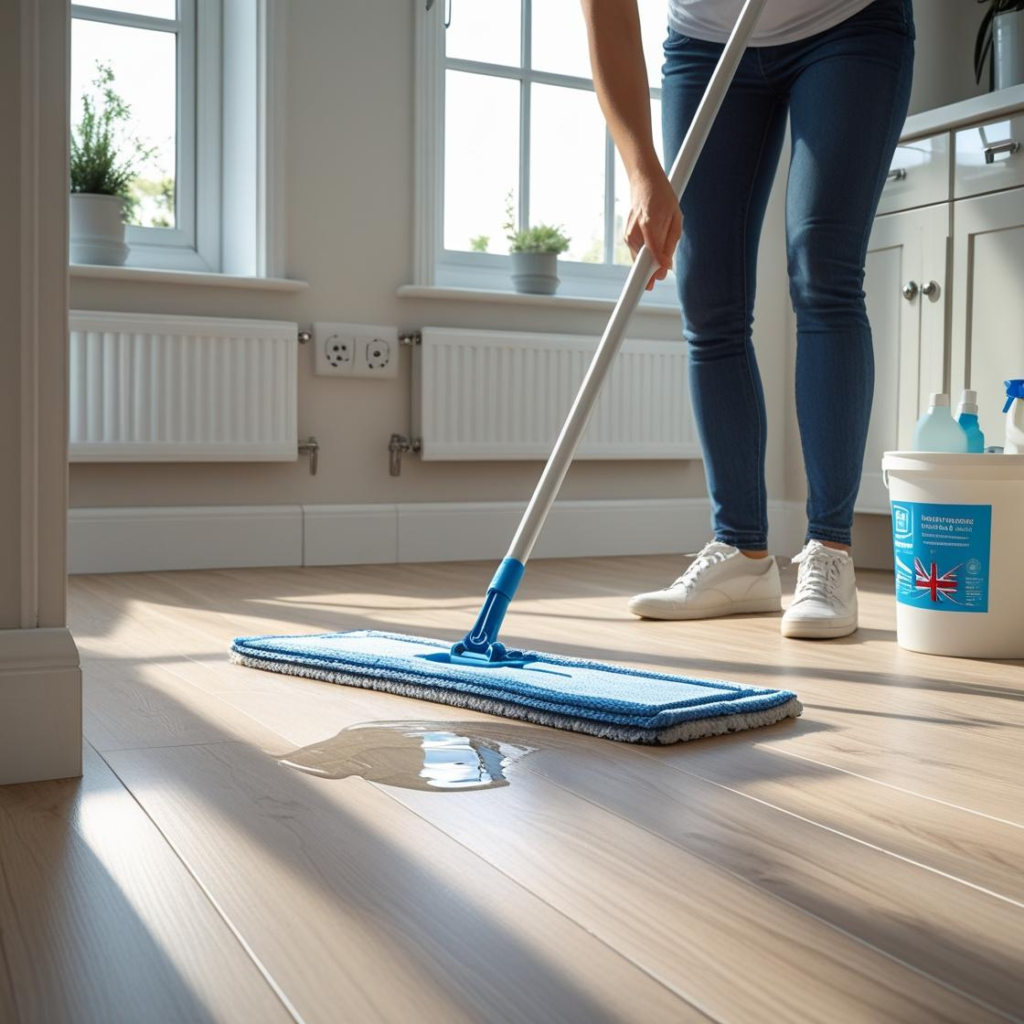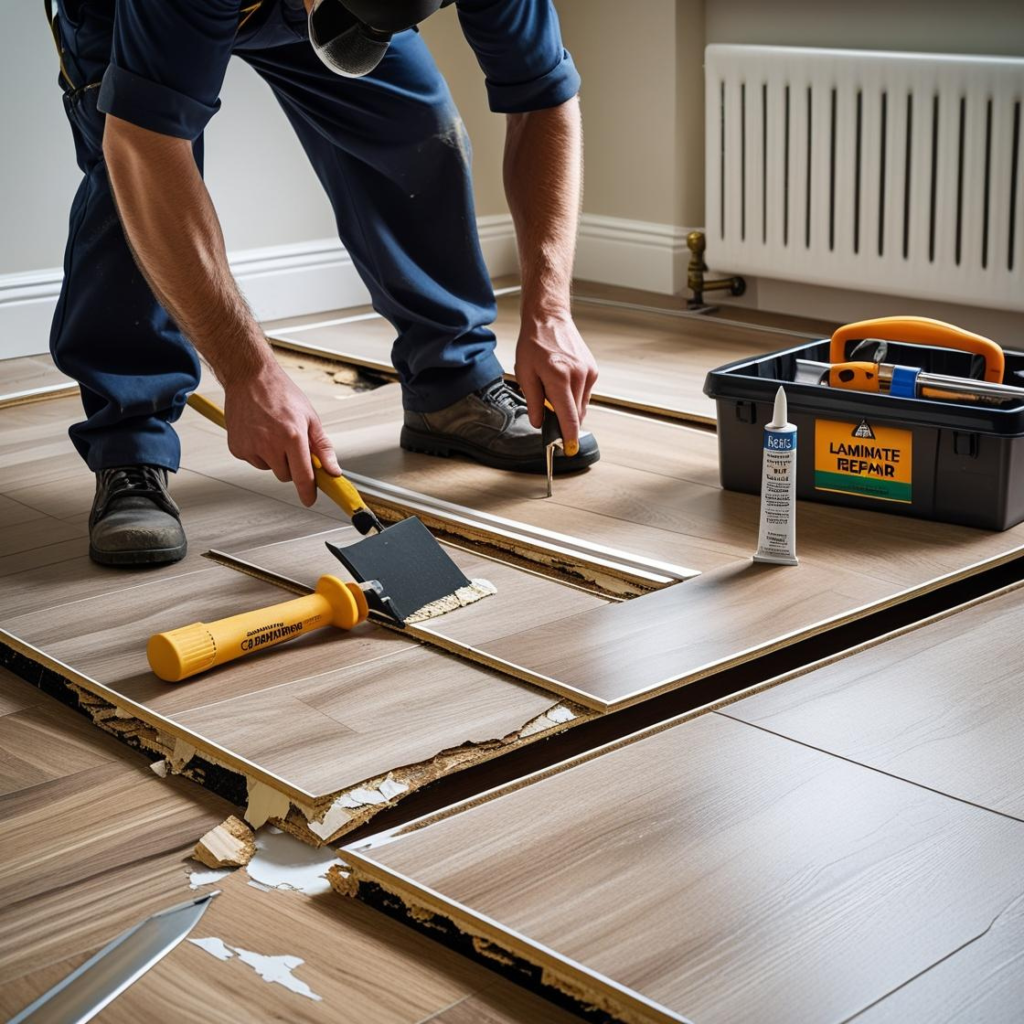Maintaining the shine and longevity of your laminate flooring can appear incredibly challenging. Yet, the key to successful cleaning doesn't involve aggressive scrubbing with potent chemicals; instead, it's about mastering the correct cleaning procedure for laminate flooring.
This method will not just retain the allure of your floors but will also prolong their life. Laminate floors provide a durable and visually appealing choice for homes, replicating the sophistication of wood floors without the excessive upkeep.
As a family-operated business that delivers quality flooring solutions right to our customers' doors, we've perfected the skill of floor care through years of practice. From identifying the optimal steam cleaner for laminate floors to perfecting the moist mop technique, our proficiency guarantees your floors stay spotless and resilient.
Let's move on to practical tips that will convert your regular floor cleaning into a simple chore.
Cleaning laminate flooring effectively necessitates the use of a microfiber mop due to its efficiency in gathering dust and dirt without scarring the surface of your laminate floor. A mildly damp or completely dry microfiber mop is always the more desirable choice, as excess water may prove detrimental to laminate flooring.
For a more extensive cleanse, select a cleaner specifically formulated and concocted for laminate floors to eradicate stubborn stains and spills while avoiding the deposition of injurious residues. This is particularly important when cleaning areas prone to grease or moisture, such as Laminate Flooring for Kitchens, where food splashes and water spills are more frequent.
Steer clear of abrasive cleaners or brushes on your laminate floors as they may induce unattractive scratches and cause wear over time. Rather, adhere to the use of soft cloths and mops created for soft brush tender cleaning.
Furthermore, we'll consider how pivotal proper maintenance of your laminate flooring is to preserving its aesthetic appeal for numerous years, especially after you lay laminate flooring and want to keep it looking fresh and well-maintained over time.

After mastering the use of a microfiber mop on your laminate floors, the next step is selecting an effective cleaner. The best laminate floor cleaners are gentle yet powerful enough to clean without damaging the surface.
It's crucial to choose a cleaning product specifically designed for laminate flooring. Many homeowners make the mistake of using harsh chemical agents that can strip away the protective layer of their laminate wood floors, leading to dullness and damage over time.
Identifying a cleaner that maintains the aesthetic appeal and durability of your laminate flooring involves reading labels carefully. Look for products that mention they are safe for use on laminate surfaces.
A good rule of thumb is to avoid anything with abrasive substances or too much moisture content. Options like white vinegar mixed with water offer a DIY solution, but ensure you follow recommended ratios to prevent harm.
Picking a suitable cleaner makes keeping your laminate floor looking fresh and new easier, protecting your investment in the long run.
Choosing the right cleaner for your laminate flooring is essential for its looks and longevity. It is critical to mention the detriments of abrasive cleaners in your cleaning regimen.
These intense chemicals can significantly harm laminate floors by removing the protective layer, leading to visible scratches or dents. This deterioration over time not only dulls the floor's appearance but could also result in more severe damage, necessitating expensive repairs.
Using abrasive cleaners on laminate flooring is like applying sandpaper to wood; it injures the surface and shortens its lifespan.
Furthermore, abrasive solutions frequently result in residues that fade the look of laminate floors, which is contrary to the aim of maintaining your new laminate floor looking bright and clean.
Homeowners, interior designers, decorators, builders, and contractors all concur that maintaining the floor's integrity is crucial for its enduring charm and durability.
Maintaining laminate flooring ensures it remains in top condition, extending its lifespan while keeping your home looking fresh and inviting. Regular cleaning is crucial; use a broom or dust mop daily to remove dirt and debris that can scratch the surface.
A microfibre mop works best for weekly cleans, picking up finer particles without damaging the floor. Always use a damp mop with a mild cleaner specifically designed for laminate floors to avoid leaving streaks or causing damage from too much water.
Protecting your laminate flooring is equally important to prevent wear and tear. Place mats at doorways to catch dirt from shoes, and consider using felt pads under the legs of the furniture to avoid scratches.
To maintain the already clean laminate floors' shine, avoid using wax or polish as these can dull the surface over time. Instead, choose products recommended for clean flooring and care that enhance its natural gloss without risking damage.
Now let's explore how too much water can be harmful and how to clean effectively with minimal moisture.
After learning about regular cleaning tips, it's crucial to focus on protecting your laminate floor from damage. This ensures that the flooring remains in top shape and extends its lifespan.
Taking these steps will significantly protect your laminate floors from familiar sources of damage, ensuring they keep looking their best for years to come.
Making laminate floors shine can transform a room, making the space feel brighter and more inviting. This requires using the right tools and techniques to protect the already clean laminate floors and keep them looking their best.
By following these steps, homeowners can easily maintain their laminate flooring’s sheen while ensuring long-term protection against wear and tear, keeping their floors gleaming for years to come.
Using dirty water or too much water on laminate floors can lead to significant damage. Laminate flooring is water-resistant, not waterproof, making it vulnerable to excessive moisture. When you clean laminate floors the right way, ensuring they remain dry and beautiful requires minimal water use.
Excess water penetrates the laminate layers, causing swelling, warping, and permanent damage that could ruin the aesthetic of your floor.
Damp mopping is key for cleaning without risking moisture damage. A wet mop picks up dirt effectively while keeping moisture levels low enough to protect the integrity of your floor.
Always wring out the mop thoroughly in standing water before using it on the surface. Alternatives to spray mops to water for cleaning include using recommended laminate floor cleaners or a mix of white vinegar and hot water that ensures cleanliness without compromising the floor’s condition.

Using ample water to cleanse your laminate floor carries considerable hazards. Water may infiltrate the crevices and joints, leading to distention, deformation, and even provoking the laminate planks to ascend or distort over time.
This moisture vulnerability harms the visual appeal of your flooring and also jeopardises its structural durability. Floors subjected to excess dampness might cultivate mould or mildew beneath, introducing health risks.
To conserve the water resistance, the aesthetics, and the durability of laminate flooring in your residence, it's vital to curtail water use during sanitation. A lightly moist mop implemented correctly certifies your floors stay appealing without endangering water impairment.
By circumventing excessive dampness on the floor's finish, you safeguard your expenditure and preserve it in its prime for future years.
Damp mopping can effectively clean your laminate floor without causing damage. Since excessive moisture and laminate floors do not mix well, occasional damp mopping using this technique is the best option for regular cleaning.
Cleaning laminate floors without water avoids excessive moisture risks and supports a low-maintenance routine. One popular choice is using distilled white vinegar—a natural cleaning agent.
Create a mixture of one part vinegar to three parts water in a spray bottle. Lightly mist small sections and wipe with a microfiber cloth. This method is ideal for quick spot cleaning and adds beauty and shine to clean surfaces.
For deeper cleans, opt for commercial laminate floor cleaners specifically designed to rid dirt without damaging the surface. Always follow the manufacturer's instructions to preserve the floor’s durable finish and warranty.
Do not dip mops directly into strong solutions or apply cleaners with heavy splashing. Laminate is prone to damage when soaked. Always use a weak solution and rinse the area lightly if needed.
Still wondering about the best way to clean laminate flooring? Visit the manufacturer’s website for more information, or contact a flooring specialist. Remember, keeping your floors clean is not just about shine—it’s about longevity.
If issues occur or you’re in doubt, there’s a lot you can learn by reaching out. Don’t hesitate to ask questions—you’ll be on the right track to keeping your floors looking their best.
To clean laminate floors, you need to choose products carefully. Recommended laminate floor cleaners are crucial for maintaining the appearance and longevity of your flooring. These should be free from any abrasive tools or substances that can damage the delicate surface.
Start by sweeping regularly with a soft-bristle broom or vacuuming laminate floors using a setting that won’t scratch. This removes loose dirt and crumbs and prevents the floor from being slippery during the cleaning process.
Many homeowners also turn to white vinegar as a natural cleaning agent. Mix one part vinegar with three parts clean water to create a gentle yet effective cleaner for laminate floors without leaving residue or causing damage. Always rinse lightly if needed and avoid overly wet methods to reduce the risk of water damage.
For those preferring DIY solutions, combining distilled water with a small amount of dishwashing detergent or a weak solution can work wonders in removing grime while preserving the floor’s shine and preventing dullness.
Always use these solutions sparingly to avoid soaking the laminate, which could lead to warping or swelling of the boards. Never use steam mops, bleach, steel wool, or harsh chemicals as they can dull or damage the surface. Also, avoid wearing shoes indoors to reduce scuff marks and scrape risks.
White vinegar stands out as an effective cleaning solution for laminate floors. Its natural acidity helps to rid the surface of grime and scuffs without harming the finish. Homeowners often mix one part white vinegar with three parts water. This low-maintenance method is ideal for regular upkeep.
People favour white vinegar because it's affordable, eco-friendly, and safer for sensitive surfaces compared with many chemical cleaners. For scuff marks, use a plastic knife to lift gently without damage, and a bit of white spirit on a soft cloth can help for tougher spots—observe and test in a small area first.
Keeping your laminate flooring clean and shiny is not a challenging task. Use the right tools and cleaners, and follow proper cleaning methods to avoid damage. Occasional damp mopping with a microfiber mop works best. For deep cleaning, choose products meant for laminate floors or make your own best option solution.
Moving on from using white vinegar, let's explore several DIY cleaning solutions for your laminate floors. These homemade mixes can help keep your floor looking new and maintain its shine without causing damage.
Each of these DIY solutions provides an effective way to clean laminate flooring and keep your laminate floor clean, while keeping it looking as good as new. laminate flooring comes with range flexibility and aesthetic appeal; maintaining it properly ensures that its beauty lasts for years.

Keeping your laminate flooring clean and shiny is not a challenging task. Use the right tools and cleaners to clean laminate flooring without causing damage. Damp mopping with a microfiber mop works best. For deep cleaning, choose products designed specifically for laminate floors or make your own solution.
By doing these things, you keep your floors looking their best for years. If questions occur, keep in mind that proper maintenance protects both appearance and value. Feel free to contact professionals with any specific issues.